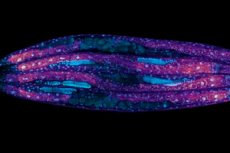New publications
A study in a C. elegans model shows that the balance of mRNAs in cells affects lifespan
Last reviewed: 02.07.2025

All iLive content is medically reviewed or fact checked to ensure as much factual accuracy as possible.
We have strict sourcing guidelines and only link to reputable media sites, academic research institutions and, whenever possible, medically peer reviewed studies. Note that the numbers in parentheses ([1], [2], etc.) are clickable links to these studies.
If you feel that any of our content is inaccurate, out-of-date, or otherwise questionable, please select it and press Ctrl + Enter.

Why do some people live longer than others? The genes in our DNA are important in helping us avoid disease and maintain overall health, but differences in genome sequence explain less than 30% of the natural variation in human lifespan.
Probing the effects of aging at the molecular level could shed light on variations in lifespan, but collecting data at the speed, scale, and quality needed to study this in humans is impossible. So researchers are turning to worms (Caenorhabditis elegans). Humans have many biological similarities to these little creatures, which also have a large natural variation in lifespan.
Researchers at the Centre for Genomic Regulation (CRG) monitored thousands of genetically identical worms in a controlled environment. Even when diet, temperature, and exposure to predators and pathogens were the same for all the worms, many of them continued to live longer or shorter than the average.
The study traced the root cause of this variation to changes in the levels of mRNA in germline cells (cells involved in reproduction) and somatic cells (cells that form the body). The balance of mRNA between these two cell types becomes disrupted, or "uncoupled," over time, causing some individuals to age more quickly than others. The findings are published in the journal Cell.
The study also found that the extent and speed of the decoupling process is regulated by a group of at least 40 different genes. These genes play many different roles in the body, from metabolism to the neuroendocrine system. But the study is the first to show that they all interact to cause some individuals to live longer than others.
Turning off some genes increased the lifespan of the worms, while turning off others shortened it. These results suggest a surprising possibility: natural differences in aging in worms may reflect randomness in the activity of many different genes, making it appear that individuals have been subjected to having many different genes turned off.
"Whether a worm lives to 8 or 20 days depends on seemingly random differences in the activity of these genes. Some worms seem to be just lucky in that they have the right set of genes activated at the right time," says Dr Matthias Eder, first author of the paper and a researcher at the Centre for Genomic Regulation.
Knocking out three genes—aexr-1, nlp-28, and mak-1—had a particularly dramatic effect on lifespan variation, reducing the range from about 8 days to just 4. Rather than extending the lives of all individuals uniformly, removing any one of these genes significantly increased the lifespan of the short-lived worms, while the lifespan of the longest-lived worms remained virtually unchanged.
The researchers observed the same effects on health span, the period of life spent in health rather than just physical life. Knocking out just one of the genes was enough to disproportionately improve healthy aging in worms with low health span.
"This isn't about making immortal worms, it's about making the aging process fairer than it is now. We're essentially doing what doctors do - taking worms that would die earlier than their peers and making them healthier, helping them live closer to their maximum potential lifespan. But we're doing that by targeting the underlying biological mechanisms of aging, rather than just treating sick individuals. This essentially makes the population more uniform and longer-lived," said Dr. Nick Stroustrup, senior author of the study and team leader at the Center for Genomic Regulation.
The study does not address why disabling the genes does not seem to negatively impact the worms' health.
"Several genes may interact to provide built-in redundancy after a certain age. It may also be that genes are not needed by individuals living in a safe, cushy environment, like a laboratory. In the harsh conditions of the wild, these genes may be more critical to survival. These are just some of the working theories," says Dr. Eder.
The researchers made their discoveries by developing a method that measures RNA molecules in different cells and tissues, combining it with the "Lifespan Machine," a device that tracks the entire lives of thousands of nematodes at once. The worms live in a petri dish inside the machine, under the scanner's eye.
The device films the nematodes once an hour, collecting a wealth of data on their behavior. The researchers plan to create a similar machine to study the molecular causes of aging in mice, whose biology more closely resembles that of humans.
